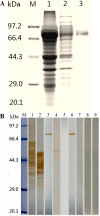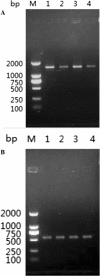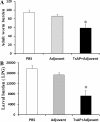Molecular characterization of Trichinella spiralis aminopeptidase and its potential as a novel vaccine candidate antigen against trichinellosis in BALB/c mice
- PMID: 23972034
- PMCID: PMC3765106
- DOI: 10.1186/1756-3305-6-246
Molecular characterization of Trichinella spiralis aminopeptidase and its potential as a novel vaccine candidate antigen against trichinellosis in BALB/c mice
Abstract
Background: Trichinella spiralis is an intracellular parasite that can cause a serious threat to human health by causing trichinellosis. The aminopeptidase (AP) was found in the proteins produced by T. spiralis infective larvae after in vitro co-culture with intestinal epithelial cells, but its characteristics and function are unknown. The purpose of this study was to identify the T. spiralis aminopeptidase (TsAP) and to investigate its potential as a vaccine candidate antigen against T. spiralis infection.
Methods: T. spiralis aminopeptidase (TsAP) gene encoding a 54.7 kDa protein was cloned and expressed in Escherichia coli, and purified recombinant TsAP protein was used to immunize BALB/c mice. The antibodies obtained were used to determine where TsAP was localized in the parasite. Transcription and expression of TsAP in different developmental stages of T. spiralis were observed by RT-PCR and Immunofluorescence test (IFT). The immune protection of recombinant TsAP protein against T. spiralis infection in BALB/c mice was evaluated.
Results: Anti-TsAP antibodies recognized the native protein migrating at 54.7 kDa by Western blotting of the crude antigens from muscle larvae. Transcription and expression of TsAP gene was observed in different developmental stages (adult worms, newborn larvae, pre-encapsulated larvae and muscle larvae). TsAP appears to be a cytoplasmic protein located primarily at the cuticle and internal organs of this parasite. After a challenge infection with T. spiralis infective larvae, mice immunized with the recombinant TsAP protein displayed a 38.1% reduction in adult worm burden and 59.1% reduction in muscle larval burden.
Conclusions: In this study, T. spiralis aminopeptidase (TsAP) was first characterized and will help reveal its potential biological functions. TsAP is a novel potential vaccine candidate antigen that merits further investigation.
Figures





Similar articles
-
Characterization of a Trichinella spiralis aminopeptidase and its participation in invasion, development and fecundity.Vet Res. 2020 Jun 15;51(1):78. doi: 10.1186/s13567-020-00805-w. Vet Res. 2020. PMID: 32539772 Free PMC article.
-
Molecular identification of Trichinella spiralis nudix hydrolase and its induced protective immunity against trichinellosis in BALB/c mice.Parasit Vectors. 2014 Dec 19;7:600. doi: 10.1186/s13071-014-0600-9. Parasit Vectors. 2014. PMID: 25522912 Free PMC article.
-
Cloning, expression and characterization of a Trichinella spiralis serine protease gene encoding a 35.5 kDa protein.Exp Parasitol. 2013 Jun;134(2):148-54. doi: 10.1016/j.exppara.2013.03.004. Epub 2013 Mar 15. Exp Parasitol. 2013. PMID: 23501807
-
Vaccines against Trichinella spiralis: Progress, challenges and future prospects.Transbound Emerg Dis. 2018 Dec;65(6):1447-1458. doi: 10.1111/tbed.12917. Epub 2018 Jun 6. Transbound Emerg Dis. 2018. PMID: 29873198 Review.
-
Induction of protection in murine experimental models against Trichinella spiralis: an up-to-date review.J Helminthol. 2015 Sep;89(5):526-39. doi: 10.1017/S0022149X15000140. Epub 2015 Mar 12. J Helminthol. 2015. PMID: 25761655 Review.
Cited by
-
Molecular characterization of a 31 kDa protein from Trichinella spiralis and its induced immune protection in BALB/c mice.Parasit Vectors. 2018 Dec 5;11(1):625. doi: 10.1186/s13071-018-3198-5. Parasit Vectors. 2018. PMID: 30518426 Free PMC article.
-
Trichinella britovi muscle larvae and adult worms: stage-specific and common antigens detected by two-dimensional gel electrophoresis-based immunoblotting.Parasit Vectors. 2018 Nov 12;11(1):584. doi: 10.1186/s13071-018-3177-x. Parasit Vectors. 2018. PMID: 30419953 Free PMC article.
-
Identification of early diagnostic antigens from major excretory-secretory proteins of Trichinella spiralis muscle larvae using immunoproteomics.Parasit Vectors. 2014 Jan 22;7:40. doi: 10.1186/1756-3305-7-40. Parasit Vectors. 2014. PMID: 24450759 Free PMC article.
-
Mapping of the complement C9 binding domain on Trichinella spiralis paramyosin.Parasit Vectors. 2014 Feb 24;7:80. doi: 10.1186/1756-3305-7-80. Parasit Vectors. 2014. PMID: 24564979 Free PMC article.
-
Advancing a multivalent 'Pan-anthelmintic' vaccine against soil-transmitted nematode infections.Expert Rev Vaccines. 2014 Mar;13(3):321-31. doi: 10.1586/14760584.2014.872035. Epub 2014 Jan 6. Expert Rev Vaccines. 2014. PMID: 24392641 Free PMC article. Review.
References
Publication types
MeSH terms
Substances
LinkOut - more resources
Full Text Sources
Other Literature Sources
Medical

